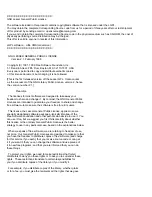
NOTE:
You can change the BFD liveness detection parameters at any time without
stopping or restarting the existing session; BFD automatically adjusts to the new
parameter value. However, no changes to BFD parameters take place until the values
resynchronize with each peer.
Related Topics
■
For details on liveness detection negotiation, see
Negotiation of the BFD Liveness
Detection Interval
in the
JUNOSe IP Services Configuration Guide
■
Basic MPLS Configuration Tasks on page 264
■
Additional RSVP-TE Configuration Tasks on page 282
■
mpls rsvp bfd-liveness-detection
Configuring IGPs and MPLS
You can use the
tunnel mpls autoroute announce
command to configure a tunnel
to announce its endpoint to IS-IS or OSPF so that the IGP can then use the LSP as a
shortcut to a destination based on the LSP’s metric.
If no tunnels are registered, the IGP calculates the shortest path to a destination by
using the shortest path first (SPF) algorithm. The results are represented by the
destination node, next-hop address, and output interface, where the output interface
is a physical interface.
If you configure an LSP to be announced to the IGP with a certain metric, the LSP
appears as a logical interface directly connected to the LSP endpoint. The IGP can
consider the LSP as a potential output interface for the LSP endpoint and for
destinations beyond the endpoint. In this case, the SPF computation results are
represented by the destination node and the output LSP, effectively using the LSP
as a shortcut through the network to the destination.
By default, IS-IS and OSPF always use the MPLS tunnel to reach the tunnel endpoint.
Best paths determined by SPF calculations are not considered. You can enable the
consideration of best paths by issuing the IS-IS or OSPF
mpls spf-use-any-best-path
command. This command causes the IGP to evaluate the LSP as it does any other
path. The IGP then either forwards traffic along the best path (which might be the
MPLS tunnel), or load-balances between the MPLS tunnel and another path.
The default behavior applies only to reaching the tunnel endpoint itself. For prefixes
downstream of the tunnel endpoint, the value of the tunnel metric always determines
whether the IGP uses the LSP or the native path, or load-balances between the native
path and one or more LSPs.
The tunnel metric can be absolute or relative. An
absolute
metric indicates there is
no relationship to the underlying IGP cost. A
relative
metric is added to or subtracted
from the underlying IGP shortest path cost.
Configuring IGPs and MPLS
■
291
Chapter 3: Configuring MPLS
Summary of Contents for JUNOSE
Page 6: ...vi...
Page 8: ...viii JUNOSe 11 0 x BGP and MPLS Configuration Guide...
Page 24: ...xxiv Table of Contents JUNOSe 11 0 x BGP and MPLS Configuration Guide...
Page 37: ...Part 1 Border Gateway Protocol Configuring BGP Routing on page 3 Border Gateway Protocol 1...
Page 38: ...2 Border Gateway Protocol JUNOSe 11 0 x BGP and MPLS Configuration Guide...
Page 234: ...198 Monitoring BGP JUNOSe 11 0 x BGP and MPLS Configuration Guide...
Page 236: ...200 Multiprotocol Layer Switching JUNOSe 11 0 x BGP and MPLS Configuration Guide...
Page 298: ...262 Point to Multipoint LSPs Configuration JUNOSe 11 0 x BGP and MPLS Configuration Guide...
Page 536: ...500 Monitoring BGP MPLS VPNs JUNOSe 11 0 x BGP and MPLS Configuration Guide...
Page 538: ...502 Layer 2 Services Over MPLS JUNOSe 11 0 x BGP and MPLS Configuration Guide...
Page 604: ...568 Virtual Private LAN Service JUNOSe 11 0 x BGP and MPLS Configuration Guide...
Page 618: ...582 VPLS References JUNOSe 11 0 x BGP and MPLS Configuration Guide...
Page 674: ...638 Virtual Private Wire Service JUNOSe 11 0 x BGP and MPLS Configuration Guide...
Page 718: ...682 Monitoring MPLS Forwarding Table for VPWS JUNOSe 11 0 x BGP and MPLS Configuration Guide...
Page 719: ...Part 6 Index Index on page 685 Index 683...
Page 720: ...684 Index JUNOSe 11 0 x BGP and MPLS Configuration Guide...















































